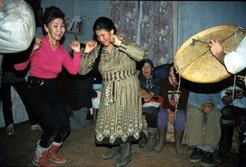Translocality and Symbols of Collective Identities in Native Communities in Kamchatka.
Translocality and Symbols of Collective Identities in Native Communities in Kamchatka.
These economic and ecological themes, as well as political issues and the rebuilding of collective identities in the Russian North, were the focus of the international conference "Postsocialisms in the Russian North" that I organised at the Max Planck Institute for Social Anthropology in November 8-9, 2000 (Kasten, ed. 2002a).
Cultural property, i.e. the promotion (or creation) of symbols of collective identities or ethnicity in the process of claiming indigenous rights or entitlements, among others with respect to access or ownership to tangible property such as land, is the second prominent theme of my research. Native art and craft traditions, and especially dances, received already in Soviet times additional meaning because they received significant state support for propaganda reasons, for example through ethnic festivals and as part of the work in so-called agitkultbrigady (agitation-culture-brigades). Native performers have happily adapted such models offered by the state to their advantage, as this meant privileges such as travel, even to western countries even during the Soviet period. Today, native art and dance traditions continue and seem to gain even more traditional meaning within the local context for maintaining or strengthening family and group identities.

At the same time, already existing ways of commodification of such traditions have received new impetus while they become more privately organised. Following western models of promoting indigenous rights, they are also used by native leaders to underline internationally ethnic status and claims connected to it by means of displaying of what is perceived as the cultural property of the respective ethnic group.
The workshop "A World of Cultures: Culture as Property in Anthropological Perspective", organised by Deema Kaneff and myself that will be held July 1-2, 2002 at the Max Planck Institute for Social Anthropology will further explore such issues of cultural property in the Russian North and discuss them comparatively.
After my initial contribution at the first conference on the Jesup Expedition at the American Museum of Natural History in New York in 1997, a broader comparison of my findings on cultural property issues in Kamchatka and in the Canadian Pacific Northwest will be presented at a second meeting in Sapporo, Japan, in October 2002.
Associated projects
Some of these main topics of my research are part of collaborative projects with other academic institutions in Germany and in Kamchatka. These go back to the mid-1990s and were extended under the current program at the Max Planck Institute and some of them will continue into the future.
Several joint projects on ecological and environmental issues with researchers of the Kamchatka Institute of Ecology and Resource Management in Petropavlovsk-Kamchatski started during my former affiliation with the Free University in Berlin (Kasten/Dulchenko ed., 1996) and continue to date. Another co-authored monograph on the Even of the Bystrinski Rayon in Central Kamchatka will come out in May 2003 (in Russian).
Collaborative projects with native researchers at the Institute for Advanced Teachers Training in Palana and with the Kamchatka State Pedagogical University, supported by the Franckesche Stiftungen zu Halle and the UNESCO have resulted in a number of workshops in Kamchatka (Kasten, ed. 2002b) and the production of teaching materials for local schools (Dürr/Kasten/Khaloimova 2001). These activities are mostly concerned with the preservation of endangered languages and traditional knowledge. They exist in connection with a current project at the Museum of Ethnology in Berlin, funded by the Deutsche Forschungsgemeinschaft, which focuses on contextual variations in perfomative arts and material culture of Koryak groups in the northern parts of Kamchatka.
